Artists as Problem Seekers
Hatanaka: I find it interesting that Lifepatch's activities may or may not be "art", even though it is important that they remain recognized by the "art" community. What is your take on this situation? Perhaps it's more accurate to say that your activities function within a social realm, and that one of these societies is the "art" community, but that there is no need for them to necessarily be reclaimed within the context or framework of "artistic" practice per se.
Andreas: There was a discussion the other night at the symposium *4 where someone stated that artists are "problem solvers." I actually disagree. I think that artists are problem seekers; to constantly question those around her or him and dig out problems that lie hidden underneath our awareness. I think that's how artists work. And when you're working as an artist, digging out problems, it's great to have scientists around you to help better understand the problems, because scientists are the actual problem solvers.
I think this is what's great about Lifepatch working within the art scene, and the first and foremost aspect that allows this is the fact that our collective is not yet strictly identified. We wouldn't be able to do what we do in the field of science because there is the convention of peer reviews, submitting publications, reproducible experiments and so on. I don't think they will even accept a paper from a just recently-established citizens' initiative; we're barely a legal entity in most formal institutions' eyes. The art scene, however, is more flexible. A lot of Lifepatch's projects are seen as relevant within the art scene, so they invite us to participate.
The second thing is that, as I said, the problems you seek, as an artist, are all around you all the time. They are everywhere in Indonesia, a lot of which are very simple. Although the nature of the questions change depending on the social contexts, our diversity—having members from different social and professional backgrounds—can offer different perspectives on those problems, which makes things all the more interesting. I think that's the two main elements of how I see Lifepatch and the art scene functioning.
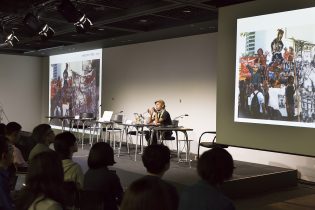

*4 International Symposium for Media Art Art & Technology: Changing Times, Contemporary Trends, Future Platforms, International Symposium of Media Art organized by the Japan Foundation Asia Center and Arts Council Tokyo, on July 9th, 2016.
Panelists: Daito Manabe (Artist / Rhizomatiks), Andreas Siagian (Artist, Engineer / Lifepatch), Jeffrey Shaw (Artist), Kazunao Abe (Deputy Director, Yamaguchi Center for Arts and Media [YCAM]), Minoru Hatanaka (Chief Curator, NTT InterCommunication Center [ICC]), Yvonne Spielmann (New media researcher)
Timbil: Why we are involved in the art scene? Why not? We know that all of us are different; we come from totally different backgrounds and we are not artists. We talk about aesthetics or art, but from our experience in the last 10 or so years, there were always some meeting points with the art scene. So, we get invited. I tell them, though "You know I'm not an artist, why did you invite me?" And they simply say "Oh, that's not a problem."
Andreas: Timbil, this is classic you, but I think it's wrong. It's too easy to say we don't know anything, that we're not artists. But, you and me, we do know a lot of things, through our practices, by literally doing it. It's very different. It goes back to the basic educational system. You majored in Chemical Engineering, but when and where are you using that knowledge? And when did you learn about fermentation? You are not taught about fermentation in chemical engineering. But now you have become an expert in fermentation precisely because you did projects on it. Students trained as an artist graduate from art schools, but a lot of them may never actually participate in an exhibition. Will they become professional artists? Of course not. They won't even know how to hang their works and put on a show. When you continue to work on particular art projects, you become a professional at it, I think.
Timbil: Well, we always evolve... We're from a city [Yogyakarta] where there are art schools, so every year, about a thousand or two thousands students graduate as artists, in Yogyakarta.
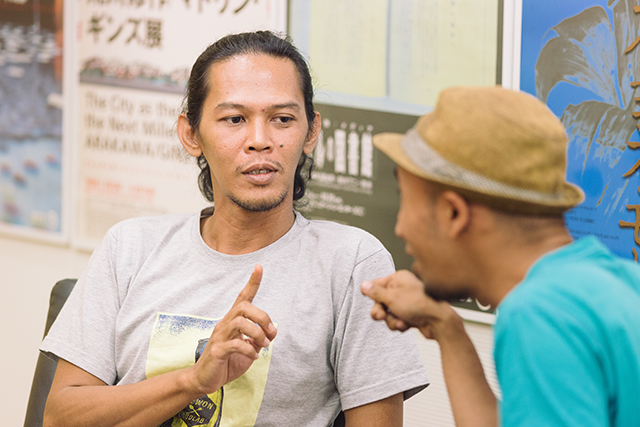
Andreas: But they end up working in a bank or in civil engineering. A lot of my friends are now bankers.
Akbar: All the projects I did in Lifepatch, I never thought of them as art installations. I never intended them to be art pieces. I completely do my projects to make prototypes and devices to make measurements of all kinds. These are my toys to play with and measure this and that. Then, somebody who sees them just suggests that we make an exhibition with them, so I simply reply, "Sure, OK, if you think it's interesting let's do it." [Laughs]
Andreas: Like in the Media/Art Kitchen exhibition sup style="color: #e9967a;">*5 in Bangkok organized by the Japan Foundation in 2013. We exhibited Moist Sense, a simple automatic irrigation system using humidity censors to measure underground moisture, as an installation. Production of circuits and devices required were based on the ideas of Akbar and others.
*5 Moist Sense, Lifepatch's installation in the Japan and Southeast Asian media art exhibition Media/Art Kitchen - Reality Distortion Field.
Oscillators connecting electronic sensors and low-frequency transmitters sending square waves, triangle waves, and noise were attached to monitor the health of the plants via audio expression.
(Organized by the Japan Foundation, exhibited in Jakarta, Kuala Lumpur, and Bangkok, 2013)
Akbar: For Media/Art Kitchen, in addition to the installation, we made a workshop on Tempe fermentation from soy bean, and we had an entirely different range of participants from an art workshop. And although I have no "artistic" mind-set for workshops, I realized that, coming from a university background, delivering information through an art form makes it easier for the people to understand what exactly I am doing. It makes the whole thing easier to access for the workshop participants.
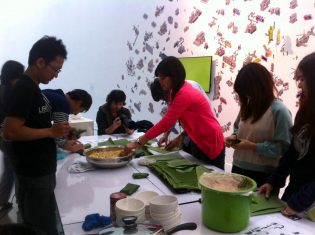
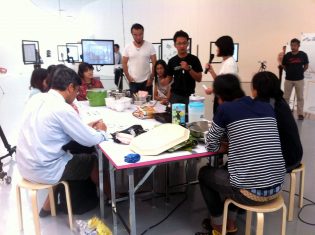
Tempe-making Workshop
Tempe is a traditional soy product originating from Indonesia (notably Java) estimated to have been consumed in Indonesia more than 2000 years. It is created by a natural culturing and controlled aerobic microbial fermentation process known as solid state fermentation (SSF) which binds the beans into a cake form. (SSF is also used in the production of Japanese koji and French blue cheese) This Tempe-making workshop was held at the Media/Art Kitchen exhibition. Fermentation is ubiquitous throughout East Asian cuisine, and this workshop was an opportunity to familiarize participants with practical bio-engineering in everyday life. (Venue: Bangkok Art and Culture Centre, BACC)
Hatanaka: I'm curious, how do you guys make a living as someone in the art world? Do you charge participants for the workshops? Do you sell your works?
Akbar: We all have our different ways. For me, workshops are a hobby so I'm doing them with my own money. But if we do have a little money, from maybe getting funding, we can put it into providing a bit of the materials for the workshops. For example, usually we ask people to bring their own: if it's a workshop on making yogurt, we ask them to bring their own milk. But if we have funding, we can provide the milk. Then, the participants just need to come, be there, and learn.
Timbil: Even our families ask us that. How do you survive? Are you an artist? Where does your money come from? Why you are invited to Japan? They don't understand. But Yogyakarta is quite an easy place to live so we still can spare our time to support our own activities. Over the past three years, Andreas, Akbar, and I had been holding many workshops, maybe once every week simply to try to make alcohol at that time. After that, we shifted to fermentation workshops that are useful for the farmers. None of us are very good at selling and profiting, actually.
Akbar: We initially intended to sell the kits, but in the end we just gave them away for free [smiles].
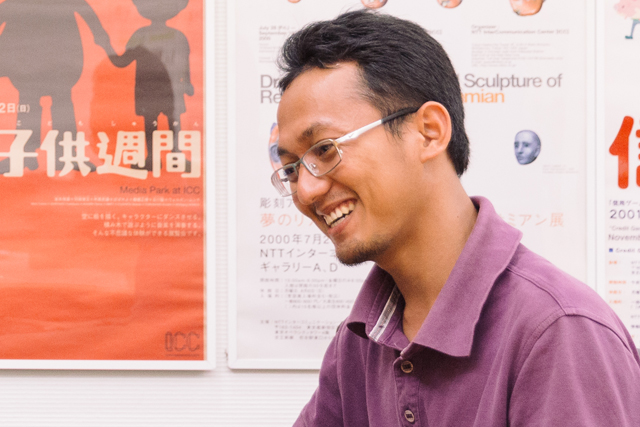
Timbil: So we work in our spare time.
Andreas: And sometimes we also cross-fund. Despite this, though, very few people will come if I organized a workshop in Indonesia and charged 5 dollars for it.
Timbil: Only two and a half people [laughs] .
Andreas: True; half for the friend who just hangs about. He'll do the workshop but he won't pay [laughs]. So workshops are never our main income, especially in Yogyakarta. But I was surprised to learn that the situation overseas is quite different. Because I did a workshop with the same module and components in The Netherlands twice, and it sold out on both occasions. On top of that, people paid 35 euros for a kit. It was surprising considering The Netherlands is a country with more advanced technology. And also from this workshop, I was invited by the Australian Government to give a workshop and an exhibition. At that time, it was quite good money for me, and I was like, "Oh, Australia, a big, fancy country with a stable economy. But they ask a neighboring country they call 'developing' country to teach them about technology." [Proudly] So maybe it's not about being "advanced," but more that the approach is different and interesting. So I think that probably makes up some of my income, and I agree with Timbil, living in Jogja is quite cheap so we're able to sustain ourselves.

Timbil: I mean, these workshops are not just about making a living. Most of our audience is farmers, and they may not even know that they really need that technology or that it might be useful to them; making organic fertilizers and simple stuff like that. I can't take money from them just for that.
Andreas: If we charge 5 dollars, no farmer will come.
Akbar: But they will still give you fruit.
All: [Laugh]
Timbil: Hands-on workshops like these are, in my opinion, one of the easiest ways to transfer and exchange knowledge. And, it is one of the things I am most proud about of our methodology, our use of technology. People are beginning to become aware of the various ways of using technology in their everyday lives, and a couple of students even wrote their graduation theses on fermentation and the Jogja River Projects *6 So, it's slowly but steadily seeping into the community's minds.
*6 The Jogja River Projects (JRP) began in 2011 through the collaboration of local communities in Yogyakarta to better understand the rivers and quality of water that flowed through urban Yogyakarta Still ongoing, documentation of social activities along the riversides, water sampling, and investigation of the watersheds are conducted.
Hatanaka: I can see that. It really is remarkable how, just as in your group name, art, science, and technology come together so organically in your practices—both as a group and individually. I look forward to continue working with you toward showing your works in our galleries. Thank you today for your time.

In front of You would come back there to see me again the following day by Michiko Tsuda
Open Space 2016: Media Conscious exhibition
NTT InterCommunication Center [ICC]
July 12, 2016
Interviewer: Minoru Hatanaka
Chief Curator of NTT InterCommunication Center [ICC]. Born in 1968, Minoru Hatanaka graduated from the Department of Art Science at Tama Art University. He has been involved in the activities of ICC since 1996, prior to the opening of the facility. The exhibitions he has curated include Sound Art—Sound as Media (2000), sounding spaces (2003), silent dialogue (2007), Exploration in Possible Spaces (2010), Vibration of Entities (2010), and [Internet Art Future]—Reality in Post Internet Era (2012). He has also curated solo exhibitions of artists, such as Dumb Type, Maywa Denki, Laurie Anderson, Kazuhiko Hachiya, Rhizomatiks, Arata Isozaki, Yoshihide Otomo, and John Wood and Paul Harrison.
Editors: Fumi Hirota, Meiko Sano (The Japan Foundation Asia Center)
Photo (Interview): Ryuichi Maruo
Cooperation: NTT InterCommunication Center [ICC] , Michiko Tsuda






